Fire Data as Proxy for Anthropogenic Landscape Change in the Yucatán
Abstract
:1. Introduction
2. Study Area
3. Methodological Approach
3.1. Data
3.2. Methods
3.3. Characterization of Land Change and Fire Patterns
3.4. Effect of Fire and Patch Size on Land Change/Persistence: A Spatial Multinomial Logit Model
3.5. Fire Frequency and Anthromes Characterization
4. Results
4.1. Spatio-Temporal Patterns of Fire and Land Change
4.2. Effect of Fire and Patch Size on Land Change/Persistence: A Spatial Multinomial Logit Model
4.3. Comparison of Fire by Anthromes
5. Discussion and Conclusions
Acknowledgments
Author Contributions
Conflicts of Interest
Appendix A
| LN[p(NFP)/(FP)] | |||||
| Estimate | Odds | p-Value | Standard Error | z-Score | |
| Intercept | 4.38 | 79.63 | 0.00 | 0.00 | 30,014.70 |
| CY | −0.07 | 0.94 | 0.00 | 0.00 | −537.22 |
| fire density | 1.72 | 5.59 | 0.00 | 0.00 | 66,617.78 |
| distance to roads | −0.54 | 0.58 | 0.00 | 0.00 | −428.23 |
| Elevation | −0.01 | 0.99 | 0.00 | 0.00 | −74.17 |
| slope (degrees) | −0.06 | 0.95 | 0.00 | 0.00 | −15.75 |
| cattle density | 0.06 | 1.06 | 0.00 | 0.00 | 58.25 |
| ejido lands | −0.39 | 0.68 | 0.00 | 0.00 | −4265.32 |
| population density change | 0.00 | 1.00 | 0.87 | 0.00 | 0.17 |
| precipitation | 0.00 | 1.00 | 0.00 | 0.00 | −7.67 |
| protected areas | 0.46 | 1.59 | 0.00 | 0.00 | 7034.54 |
| Soil | −0.10 | 0.91 | 0.00 | 0.00 | −4248.04 |
| LN[p(FP)/(NFP)] | |||||
| Estimate | Odds | p-Value | Standard Error | z-Score | |
| Intercept | −4.38 | 0.01 | 0.00 | 0.00 | −29,981.84 |
| CY | 0.07 | 1.07 | 0.00 | 0.00 | 530.89 |
| FIRE_intensity | −1.72 | 0.18 | 0.00 | 0.00 | −67,202.89 |
| dist_roads | 0.54 | 1.72 | 0.00 | 0.00 | 427.89 |
| Elevation | 0.01 | 1.01 | 0.00 | 0.00 | 74.14 |
| slope_deg | 0.06 | 1.06 | 0.00 | 0.00 | 15.74 |
| cattledensity | −0.06 | 0.94 | 0.00 | 0.00 | −58.13 |
| ejido | 0.38 | 1.47 | 0.00 | 0.00 | 4261.07 |
| popdens_chenge | 0.00 | 1.00 | 0.71 | 0.00 | −0.37 |
| precip | 0.00 | 1.00 | 0.00 | 0.00 | 7.65 |
| protegidas | −0.46 | 0.63 | 0.00 | 0.00 | −7048.05 |
| soil | 0.10 | 1.10 | 0.00 | 0.00 | 4244.83 |
| LN[p(NFP)/(CH)] | |||||
| Estimate | Odds | p-Value | Standard Error | z-Score | |
| Intercept | 9.05 | 8498.41 | 0.00 | 0.00 | 123,593.53 |
| CY | 3.48 | 32.43 | 0.00 | 0.00 | 55,698.76 |
| FIRE_intensity | −0.20 | 0.82 | 0.00 | 0.00 | −14,938.93 |
| dist_roads | −0.43 | 0.65 | 0.00 | 0.00 | −687.67 |
| elevation | 0.00 | 1.00 | 0.03 | 0.00 | −2.15 |
| slope_deg | 0.58 | 1.79 | 0.00 | 0.00 | 327.37 |
| cattledensity | 0.11 | 1.11 | 0.00 | 0.00 | 218.22 |
| ejido | −0.25 | 0.78 | 0.00 | 0.00 | −5330.41 |
| popdens_chenge | −0.06 | 0.95 | 0.00 | 0.00 | −45.86 |
| precip | 0.00 | 1.00 | 0.00 | 0.00 | −39.16 |
| protegidas | 1.65 | 5.19 | 0.00 | 0.00 | 50,114.19 |
| soil | 0.42 | 1.52 | 0.00 | 0.00 | 35,985.19 |
| LN[p(CH)/(FP)] | |||||
| Estimate | Odds | p-Value | Standard Error | z-Score | |
| Intercept | −4.67 | 0.01 | 0.00 | 0.00 | −1,052,724.45 |
| CY | −3.55 | 0.03 | 0.00 | 0.00 | −770,643.97 |
| fire density | 1.92 | 6.79 | 0.00 | 0.00 | 1,416,356.73 |
| distance to roads | −0.11 | 0.90 | 0.00 | 0.00 | −4430.60 |
| elevation | −0.01 | 0.99 | 0.00 | 0.00 | −3.57 |
| slope (degrees) | −0.64 | 0.53 | 0.00 | 0.00 | −66,666.61 |
| cattle density | −0.05 | 0.95 | 0.00 | 0.00 | −1931.87 |
| ejido lands | −0.14 | 0.87 | 0.00 | 0.00 | −16,873.16 |
| population density chanve | 0.06 | 1.06 | 0.00 | 0.00 | 44.88 |
| precipitation | 0.00 | 1.00 | 0.00 | 0.00 | 39.04 |
| protected areas | −1.18 | 0.31 | 0.00 | 0.00 | −1,358,343.49 |
| soil | −0.52 | 0.59 | 0.00 | 0.00 | −423,156.99 |
| LN[p(CH)/(NFP)] | |||||
| Estimate | Odds | p-Value | Standard Error | z-Score | |
| Intercept | −6.07 | 0.00 | 0.00 | 0.00 | −1,974,081.65 |
| CY | −3.46 | 0.03 | 0.00 | 0.00 | −851,530.90 |
| FIRE_intensity | 0.20 | 1.22 | 0.00 | 0.00 | 215,160.66 |
| dist_roads | 0.44 | 1.55 | 0.00 | 0.00 | 34,899.45 |
| elevation | 0.00 | 1.00 | 0.03 | 0.00 | 2.15 |
| slope_deg | −0.47 | 0.62 | 0.00 | 0.00 | −46,646.59 |
| cattledensity | −0.11 | 0.89 | 0.00 | 0.00 | −2457.85 |
| ejido | 0.24 | 1.28 | 0.00 | 0.00 | 51,274.32 |
| popdens_chenge | 0.05 | 1.05 | 0.00 | 0.00 | 41.32 |
| precip | 0.00 | 1.00 | 0.03 | 0.00 | 2.21 |
| protegidas | −1.59 | 0.20 | 0.00 | 0.00 | −2,424,094.75 |
| soil | −0.47 | 0.62 | 0.00 | 0.00 | −526,363.39 |
| LN[p(FP)/(CH)] | |||||
| Estimate | Odds | p-Value | Standard Error | z-Score | |
| Intercept | 4.67 | 106.73 | 0.00 | 0.00 | 63,882.24 |
| CY | 3.55 | 34.66 | 0.00 | 0.00 | 56,986.69 |
| FIRE_intensity | −1.92 | 0.15 | 0.00 | 0.00 | −148,047.18 |
| dist_roads | 0.11 | 1.11 | 0.00 | 0.00 | 167.04 |
| elevation | 0.01 | 1.01 | 0.00 | 0.00 | 3.57 |
| slope_deg | 0.64 | 1.90 | 0.00 | 0.00 | 358.84 |
| cattledensity | 0.05 | 1.05 | 0.00 | 0.00 | 102.76 |
| ejido | 0.14 | 1.15 | 0.00 | 0.00 | 3038.12 |
| popdens_chenge | −0.06 | 0.95 | 0.00 | 0.00 | −44.85 |
| precip | 0.00 | 1.00 | 0.00 | 0.00 | −39.10 |
| protegidas | 1.18 | 3.27 | 0.00 | 0.00 | 35,911.95 |
| soil | 0.52 | 1.68 | 0.00 | 0.00 | 44,599.37 |
References
- Reid, W.V.; Chen, D.; Goldfarb, L.; Hackmann, H.; Lee, Y.T.; Mokhele, K.; Ostrom, E.; Raivio, K.; Rockström, J.; Schellnhuber, H.J.; et al. Earth System Science for Global Sustainability: Grand challenges. Science 2010, 330, 916–917. [Google Scholar] [CrossRef] [PubMed]
- Irwin, E.G.; Geoghegan, J. Theory, data, methods: Developing spatially explicit economic models of land use change. Agric. Ecosyst. Environ. 2001, 85, 7–24. [Google Scholar] [CrossRef]
- Agarwal, C.; Green, G.M.; Grove, J.M.; Evans, T.P.; Schweik, C.M. A Review and Assessment of Land-Use Change Models: Dynamics of Space, Time and Human Choice; Technical Report NE-297; United States Department of Agriculture (USDA): Burlington, VT, USA, 2002.
- Turner, B.L.; Lambin, E.F.; Reenberg, A. The Emergence of Land Change Science for Global Environmental Change and Sustainability. Proc. Natl. Acad. Sci. USA 2007, 104, 20666–20671. [Google Scholar] [CrossRef] [PubMed]
- Griggs, D.; Stafford-Smith, M.; Gaffney, O.; Rockström, J.; Öhman, M.C.; Shyamsundar, P.; Steffen, W.; Glaser, G.; Kanie, N.; Noble, I. Policy: Sustainable development goals for people and planet. Nature 2013, 495, 305–307. [Google Scholar] [CrossRef] [PubMed]
- Steffen, W.; Sanderson, R.A.; Tyson, P.D.; Jäger, J.; Matson, P.A.; Moore, B., III; Oldfield, F.; Richardson, K.; Schellnhuber, H.J.; Turner, B.L.; et al. Global Change and the Earth System: A Planet under Pressure; Springer: Berlin/Heidelberg, Germany; New York, NY, USA, 2004. [Google Scholar]
- Foley, J.A.; DeFries, R.; Asner, G.P.; Barford, C.; Bonan, G.; Carpenter, S.R.; Chapin, F.S.; Coe, M.T.; Daily, G.C.; Gibbs, H.K. Global consequences of Land Use. Science 2005, 309, 570–574. [Google Scholar] [CrossRef] [PubMed]
- Turner, B.L., II; Skole, D.; Sanderson, S.; Fischer, G.; Fresco, L.; Leemans, R. Land-Use and Land-Cover Change Science/Research Plan; IGBP Report No. 35; The International Geosphere-Biosphere Programme IGBP: Stockholm, Sweden, 1995. [Google Scholar]
- Kates, R.W.; Clark, W.; Corell, R. Sustainability Science; KSG Working Paper No. 00-018; John F Kennedy School of Government (KSG), Harvard University: Cambridge, MA, USA, 2000.
- Ellis, E.C.; Ramankutty, N. Putting people in the map: Anthropogenic biomes of the world. Front. Ecol. Environ. 2008, 6, 439–447. [Google Scholar] [CrossRef]
- Loveland, T.R.; Sohl, T.L.; Stehman, S.V.; Gallant, A.L.; Sayler, K.L.; Napton, D.E. A strategy for estimating the rates of recent United States land-cover changes. Photogramm. Eng. Remote Sens. 2002, 68, 1091–1099. [Google Scholar]
- Rogan, J.; Chen, D. Remote sensing technology for mapping and monitoring land-cover and land-use change. Prog. Plan. 2004, 61, 301–325. [Google Scholar] [CrossRef]
- Mertens, B.; Lambin, E.F. Land-cover-change trajectories in southern Cameroon. Ann. Assoc. Am. Geogr. 2000, 90, 467–494. [Google Scholar] [CrossRef]
- DeFries, R.S.; Foley, J.A.; Asner, G.P. Land use choices: Balancing human needs and ecosystem function. Front. Ecol. Environ. 2004, 2, 249–257. [Google Scholar] [CrossRef]
- Csiszar, I.; Justice, C.O.; Mcguire, A.D.; Cochrane, M.A.; Roy, D.P.; Brown, F.; Conard, S.G.; Frost, P.G.H.; Giglio, L.; Elvidge, C.; et al. Land use and fires. In Land Change Science: Observing, Monitoring and Understanding Trajectories of Change on the Earth’s Surface; Gutman, G., Janetos, A.C., Justice, C.O., Moran, E.F., Mustard, J.F., Rinfuss, R.R., Skole, D., Turner, B.L., II, Cochrane, M.A., Eds.; Springer: Berlin, Germany, 2004; pp. 329–351. [Google Scholar]
- Brown, D.; Band, L.E.; Green, K.O.; Irwin, E.G.; Jain, A.; Lambin, E.F.; Pontius, R.G.; Seto, K.C.; Turner, B.L., II; Verburg, P.H. Advancing Land Change Modeling: Opportunities and Research Requirements; The National Academies Press: Washington, DC, USA, 2013. [Google Scholar]
- Verburg, P.H.; Crossman, N.; Ellis, E.C.; Heinimann, A.; Hostert, P.; Mertz, O.; Nagendra, H.; Sikor, T.; Erb, K.-H.; Golubiewski, N.E.; et al. Land system science and sustainable development of the earth system: A global land project perspective. Anthropocene 2015, 12, 29–41. [Google Scholar] [CrossRef] [Green Version]
- Ronald Eastman, J.; Sangermano, F.; Ghimire, B.; Zhu, H.; Chen, H.; Neeti, N.; Cai, Y.; Machado, E.A.; Crema, S.C. Seasonal trend analysis of image time series. Int. J. Remote Sens. 2009, 30, 2721–2726. [Google Scholar] [CrossRef]
- Congalton, R.G.; Gu, J.; Yadav, K.; Thenkabail, P.; Ozdogan, M. Global land cover mapping: A review and uncertainty analysis. Remote Sens. 2014, 6, 12070–12093. [Google Scholar] [CrossRef]
- McDermid, G.J.; Franklin, S.E.; LeDrew, E.F. Remote sensing for large-area habitat mapping. Prog. Phys. Geogr. 2005, 29, 449–474. [Google Scholar] [CrossRef]
- Woodcock, C.E.; Ozdogan, M. Trends in Land-cover Mapping and Monitoring. Remote Sens. Digit. Image Process. 2004, 6, 367–377. [Google Scholar]
- Rogan, J.; Franklin, J.; Roberts, D.A. A comparison of methods for monitoring multitemporal vegetation change using Thematic Mapper imagery. Remote Sens. Environ. 2002, 80, 143–156. [Google Scholar] [CrossRef]
- Justice, C.O.; Giglio, L.; Korontzi, S.; Owens, J.; Morisette, J.T.; Roy, D.; Descloitres, J.; Alleaume, S.; Petitcolin, F.; Kaufman, Y. The MODIS fire products. Remote Sens. Environ. 2002, 83, 244–262. [Google Scholar] [CrossRef]
- Neeti, N.; Rogan, J.; Christman, Z.; Eastman, J.R.; Millones, M.; Schneider, L.; Nickl, E.; Schmook, B.; Turner, B.L.; Ghimire, B. Mapping seasonal trends in vegetation using AVHRR-NDVI time series in the Yucatán Peninsula, Mexico. Remote Sens. Lett. 2012, 3, 433–442. [Google Scholar] [CrossRef]
- Parmentier, B.; Eastman, J.R. Land transitions from multivariate time series: Using seasonal trend analysis and segmentation to detect land-cover changes. Int. J. Remote Sens. 2014, 35, 671–692. [Google Scholar] [CrossRef]
- Friedl, M.A.; McIver, D.K.; Hodges, J.C.; Zhang, X.Y.; Muchoney, D.; Strahler, A.H.; Woodcock, C.E.; Gopal, S.; Schneider, A.; Cooper, A.; et al. Global land-cover mapping from MODIS: Algorithms and early results. Remote Sens. Environ. 2002, 83, 287–302. [Google Scholar] [CrossRef]
- Miller, J.; Rogan, J. Using GIS and remote sensing for ecological mapping and monitoring. In Integration of GIS and Remote Sensing; Masev, V., Ed.; Wiley and Sons: West Sussex, UK, 2007; pp. 233–268. [Google Scholar]
- Morton, D.C.; Defries, R.S.; Randerson, J.T.; Giglio, L.; Schroeder, W.; Van Der Werf, G.R. Agricultural intensification increases deforestation fire activity in Amazonia. Glob. Chang. Biol. 2008, 14, 2262–2275. [Google Scholar] [CrossRef]
- Pausas, J.G.; Keeley, J.E. A burning story: The role of fire in the history of life. BioScience 2009, 59, 593–601. [Google Scholar] [CrossRef] [Green Version]
- Bowman, D.M.; Balch, J.; Artaxo, P.; Bond, W.J.; Cochrane, M.A.; D’antonio, C.M.; DeFries, R.; Johnston, F.H.; Keeley, J.E.; Krawchuk, M.A.; et al. The human dimension of fire regimes on Earth. J. Biogeogr. 2011, 38, 2223–2236. [Google Scholar] [CrossRef] [PubMed]
- Butsic, V.; Kelly, M.; Moritz, M.A. Land use and wildfire: A review of local interactions and teleconnections. Land 2015, 4, 140–156. [Google Scholar] [CrossRef]
- Lutz, W.; Prieto, L.; Sanderson, W.C. (Eds.) Population, Development and Environment on the Yucatan Peninsula: From Ancient Maya to 2030; International Institute for Applied Systems Analysis: Luxemburg, 2000. [Google Scholar]
- Turner, B.L., II; Geoghegan, J.; Foster, D.R. (Eds.) Integrated Land Change Science and Tropical Deforestation in the Southern Yucatán: Final Frontiers; Oxford University Press: Oxford, UK, 2004. [Google Scholar]
- Rogan, J.; Schneider, L.; Christman, Z.; Millones, M.; Lawrence, D.; Schmook, B. Hurricane Disturbance Mapping using MODIS EVI Data in the South-Eastern Yucatán, Mexico. Remote Sens. Lett. 2011, 2, 259–267. [Google Scholar] [CrossRef]
- Islebe, G.A.; Calmé, S.; León-Cortés, J.L.; Schmook, B. Biodiversity and Conservation of the Yucatán Peninsula; Springer International Publishing: New York, NY, USA, 2015. [Google Scholar]
- Vester, H.F.; Lawrence, D.; Eastman, J.R. Land change in the southern Yucatán and Calakmul biosphere reserve: Implications for habitat and biodiversity. Ecol. Appl. 2007, 17, 989–1003. [Google Scholar] [CrossRef] [PubMed]
- Schmook, B. Shifting Maize Cultivation and Secondary Vegetation in the Southern Yucatán: Forest Impacts of Temporal Intensification. Reg. Environ. Chang. 2010, 10, 233–246. [Google Scholar] [CrossRef]
- Schmook, B.; van Vliet, N.; Radel, C.; de Jesús Manzón-Che, M.; McCandless, S. Persistence of swidden cultivation in the face of globalization: A case study from communities in Calakmul, Mexico. Hum. Ecol. 2013, 41, 93–107. [Google Scholar] [CrossRef]
- Xolocotzi, H.; Baltazar, E.B. (Eds.) La Milpa de Yucatán: Un Sistema de Producción Agrícola Tradicional; Colegio de Postgraduados: Montecillo, Mexico, 1995; Tome II. [Google Scholar]
- Ressl, R.; Lopez, G.; Cruz, I.; Colditz, R.R.; Schmidt, M.; Ressl, S.; Jiménez, R. Operational active fire mapping and burnt area identification applicable to Mexican Nature Protecion Areas using MODIS and NOAA-AVHRR direct redout data. Remote Sens. Envrion. 2009, 113, 1113–1125. [Google Scholar] [CrossRef]
- Comision Nacional Forestal (CONAFOR). Los Incendios Forestales en Mexico; Technical Report; Comision Nacional Forestal: Mexico City, Mexico, 2005.
- Cheng, D.; Rogan, J.; Schneider, L.; Cochrane, M. Evaluating MODIS active fire products in subtropical Yucatán forest. Remote Sens. Lett. 2012, 4, 455–464. [Google Scholar] [CrossRef]
- Giglio, L.; Descloitres, J.; Justice, C.O.; Kaufman, Y.J. An enhanced contextual fire detection algorithm for MODIS. Remote Sens. Environ. 2003, 87, 273–282. [Google Scholar] [CrossRef]
- Giglio, L. MODIS Collection 6 Active Fire Product User’s Guide Revision A. Unpublished Manuscript, Department of Geographical Sciences, University of Maryland. Available online: https://lpdaac.usgs.gov/sites/default/files/public/product_documentation/mod14_user_guide.pdf (accessed on 22 February 2016).
- Schroeder, W.; Prins, E.; Giglio, L.; Csiszar, I.; Schmidt, C.; Morisette, J.; Morton, D. Validation of Goes and MODIS active fire detection products using ASTER and ETM+ data. Remote Sens. Environ. 2008, 112, 2711–2726. [Google Scholar] [CrossRef]
- Vaca, R.A.; Golicher, D.J.; Cayuela, L.; Hewson, J.; Steininger, M. Evidence of Incipient Forest Transition in Southern Mexico. PLoS ONE 2012, 7, e42309. Available online: http://doi.org/10.1371/journal.pone.0042309 (accessed on 13 March 2017). [CrossRef] [PubMed]
- Steininger, M.K.; Tucker, C.J.; Ersts, P.; Killeen, T.J.; Villegas, Z.; Hecht, S.B. Clearance and Fragmentation of Tropical Deciduous Forest in the Tierras Bajas, Santa Cruz, Bolivia. Conserv. Biol. 2002, 15, 1523–1739. [Google Scholar] [CrossRef]
- Ellis, E.C.; Ramankutty, N. Anthropogenic Biomes of the World; version 1; Socioeconomic Data and Applications Center (SEDAC), National Aeronautics and Space Administration (NASA): Palisades, NY, USA, 2008. Available online: http://dx.doi.org/10.7927/H4H12ZXD (accessed on 5 January 2017).
- Instituto Nacional de Estadística, Geografía e Inofrmática (INEGI). Datos Básicos de la Geografía de México. Available online: www.inegi.gob.mx (accessed on 7 February 2015).
- Getis, A.; Ord, J.K. The analysis of spatial association by use of distance statistics. Geogr. Anal. 1992, 24, 189–206. [Google Scholar] [CrossRef]
- Anselin, L. Local indicators of spatial association-LISA. Geogr. Anal. 1995, 27, 93–115. [Google Scholar] [CrossRef]
- Griffith, D.A. Moran coefficient for non-normal data. J. Stat. Plan. Inference 2010, 140, 2980–2990. [Google Scholar] [CrossRef]
- Chomitz, K.M.; Gray, D.A. Roads, land-use, and deforestation: A spatial model applied to Belize. World Bank Econ. Rev. 1996, 10, 487–512. [Google Scholar] [CrossRef]
- Verburg, P.H.; Overmars, K.P.; Witte, N. Accessibility and land-use patterns at the forest fringe in the northeastern part of the Philippines. Geogr. J. 2004, 170, 238–255. [Google Scholar] [CrossRef]
- Agresti, A. Categorical Data Analysis, 2nd ed.; John Wiley & Sons: New York, NY, USA, 2002. [Google Scholar]
- Hosmer, D.; Lemeshow, S. Applied Logistic Regression, 2nd ed.; John Wiley & Sons: New York, NY, USA, 2000. [Google Scholar]
- Millington, J.D.; Perry, G.L.; Romero-Calcerrada, R. Regression techniques for examining land use/cover change: A case study of a Mediterranean landscape. Ecosystems 2007, 10, 562–578. [Google Scholar] [CrossRef]
- Lyapustin, A.I.; Kaufman, Y.J. Role of adjacency effect in the remote sensing of aerosol. J. Geophys. Res. 2001, 106, 11909–11916. [Google Scholar] [CrossRef]
- Griffith, D.A. Spatial Autocorrelation and Spatial Filtering: Gaining Understanding through Theory and Scientific Visualization; Springer: Berlin/Heidelberg, Germany; New York, NY, USA, 2003. [Google Scholar]
- Griffith, D.A.; Layne, L.J. A Casebook for Spatial Statistical Data Analysis; Oxford University Press: Oxford, UK; New York, NY, USA, 1999. [Google Scholar]
- Turner, M.G.; Gardner, R.H.; O’neill, R.V. Landscape Ecology in Theory and in Practice: Pattern and Process; Springer: New York, NY, USA, 2001. [Google Scholar]
- Walker, R.; Moran, E.; Anselin, L. Deforestation and cattle ranching in the Brazilian Amazon: External capital and household processes. World Dev. 2000, 28, 683–699. [Google Scholar] [CrossRef]
- Bradley, A.V.; Millington, A.C. Spatial and temporal scale issues in determining biomass burning regimes in Bolivia and Peru. Int. J. Remote Sens. 2006, 27, 2221–2253. [Google Scholar] [CrossRef]
- Munroe, D.K.; Wolfinbarger, S.R.; Calder, C.A.; Shi, T.; Xiao, N.; Lam, C.Q.; Li, D. The Relationships between Biomass Burning, Land-Cover Change and the Distribution of Carbonaceous Aerosols in Main Land Southeast Asia: A Review and Synthesis; Department of Statistics Preprint 793; The Ohio State University: Columbus, OH, USA, 2007. [Google Scholar]
- Pfaff, A.J. What drives tropical deforestation in the Brazilian Amazon? Evidence from satellite and socioeconomic data. J. Environ. Econ. Manag. 1999, 37, 26–43. [Google Scholar] [CrossRef]

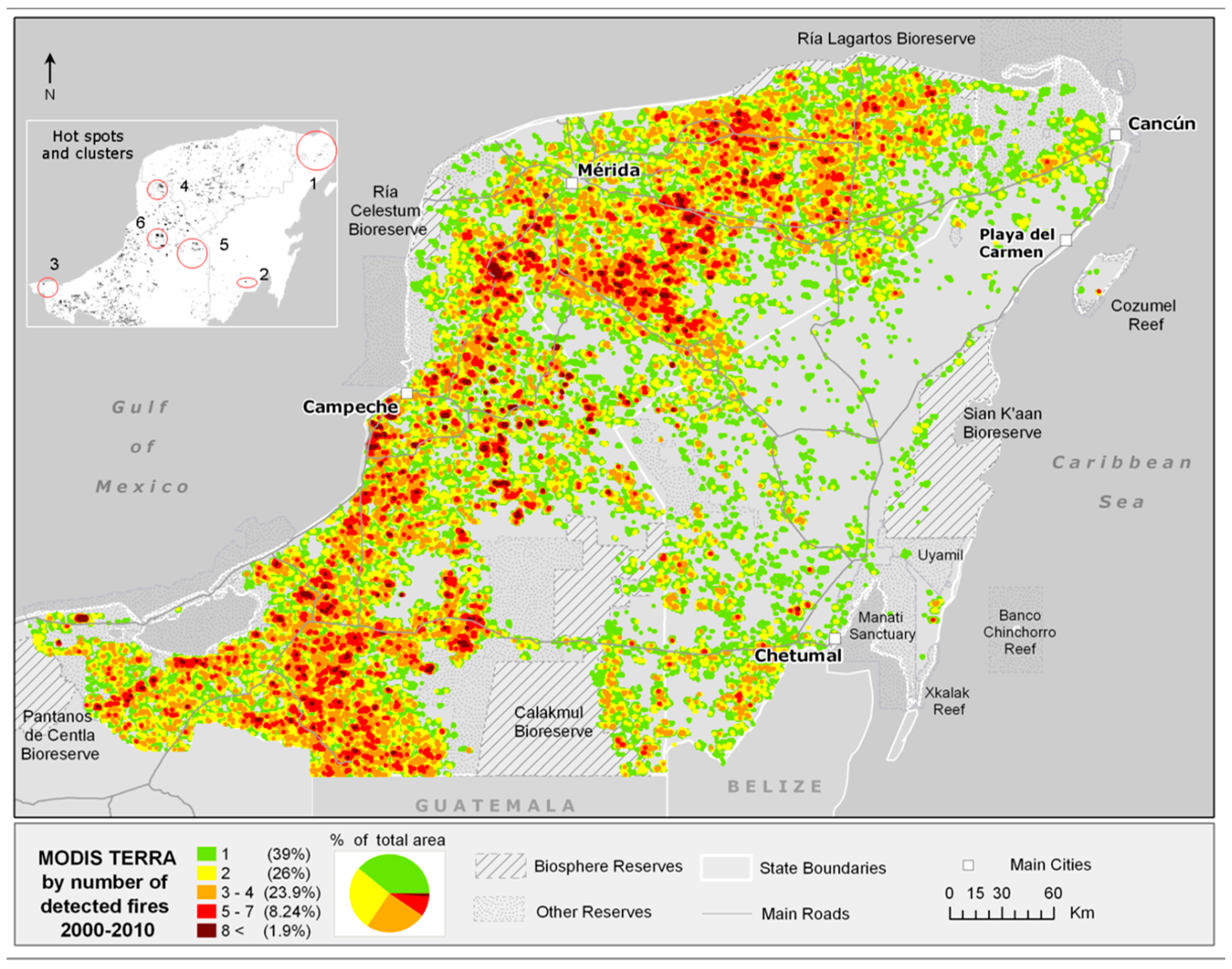
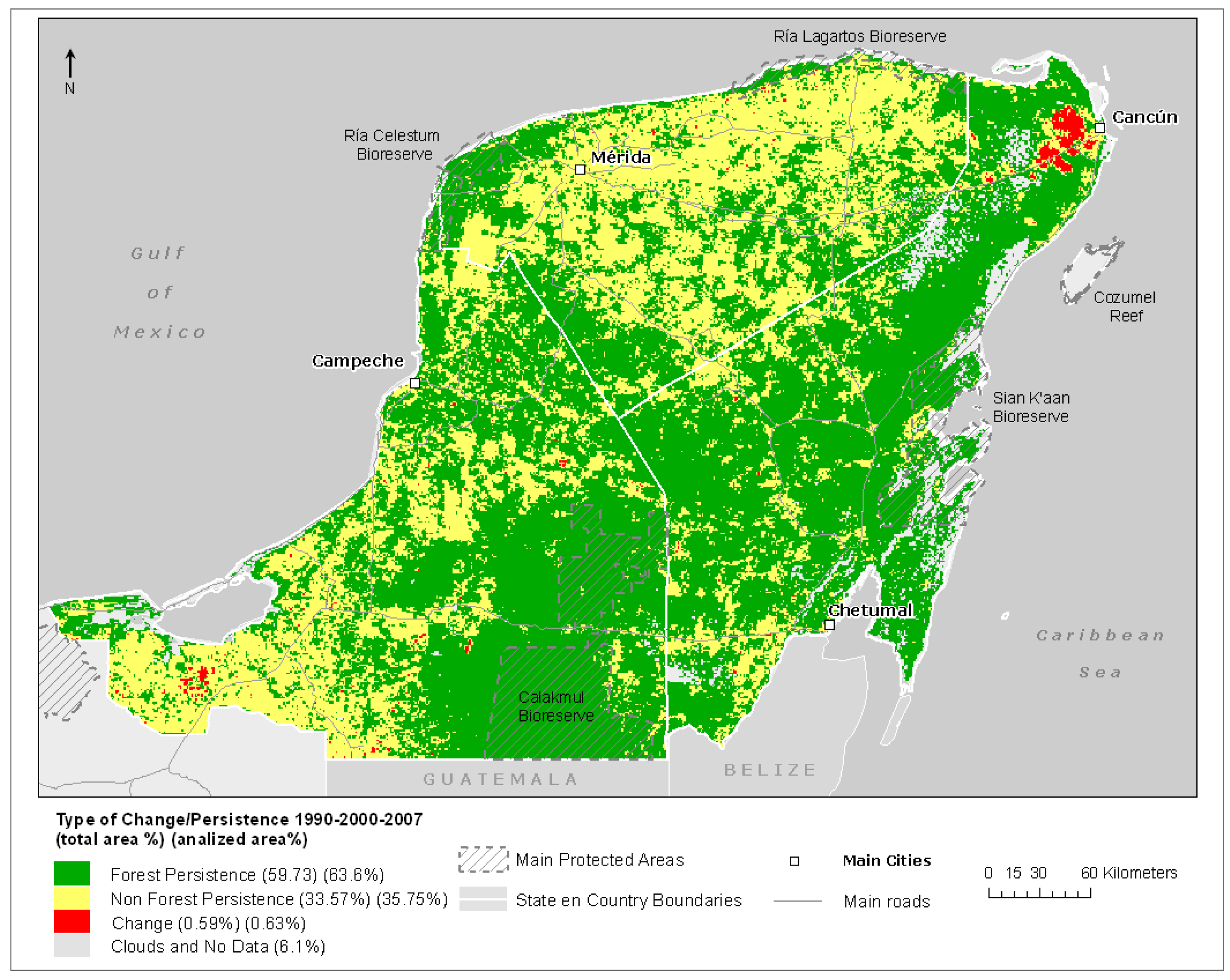
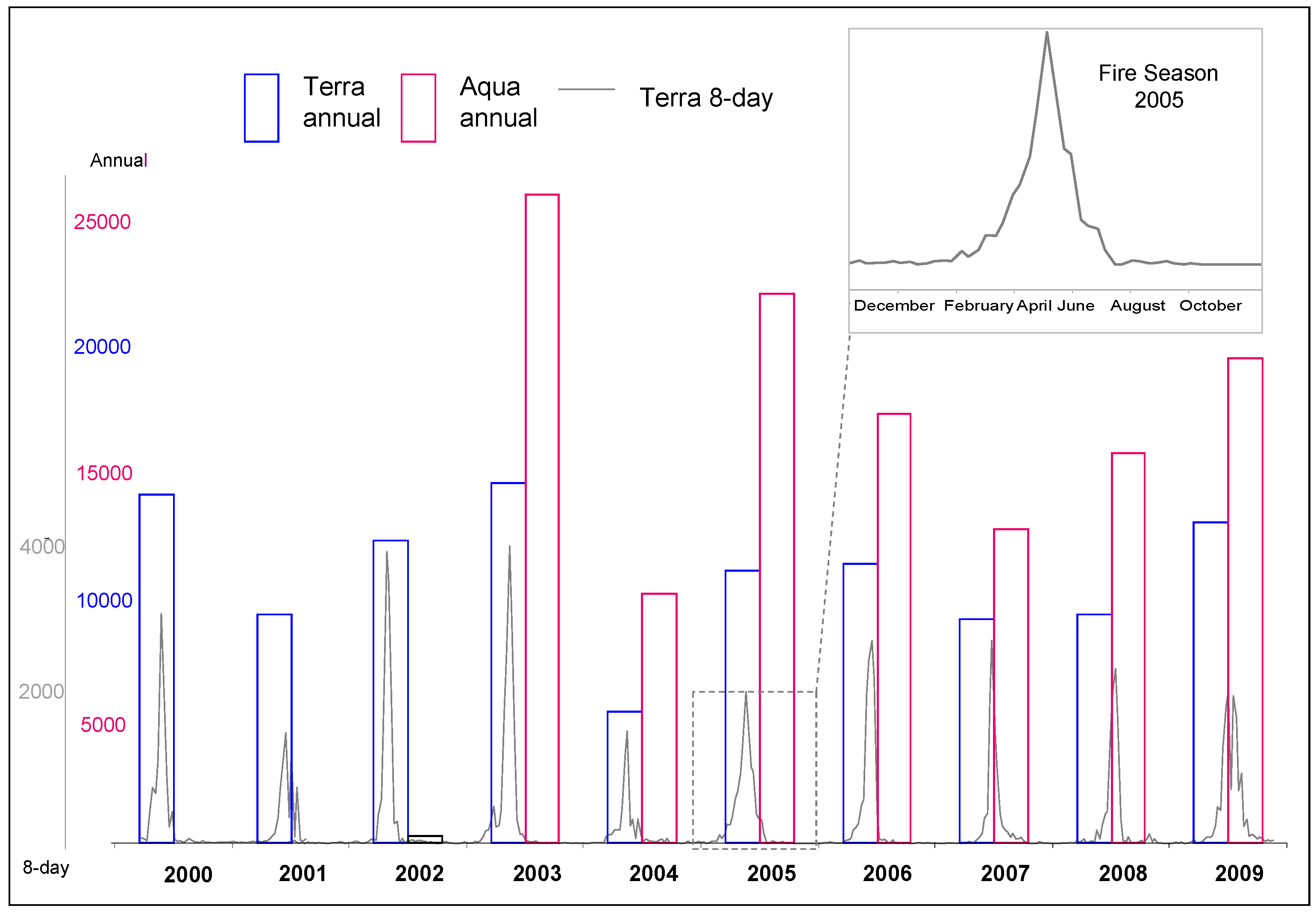
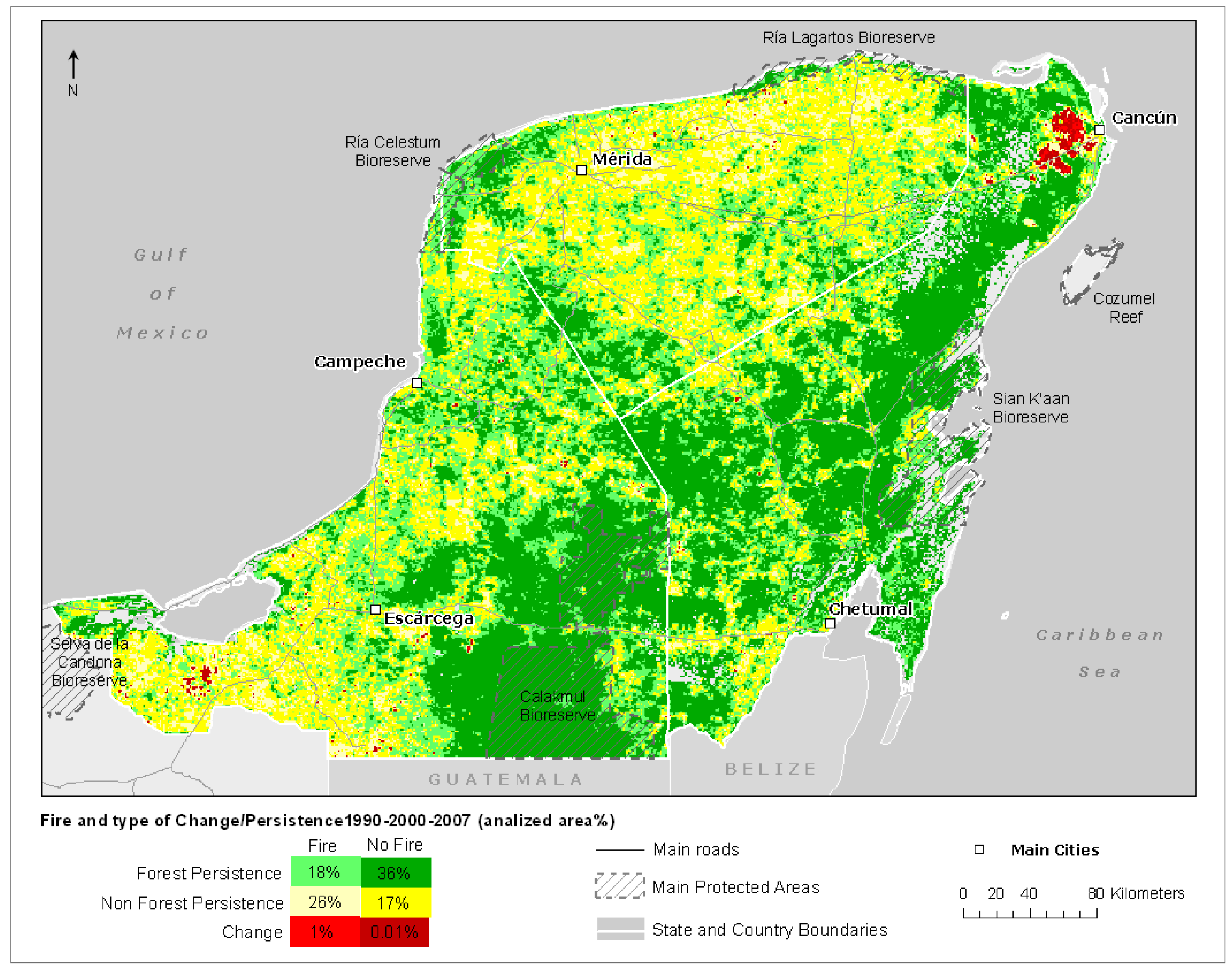
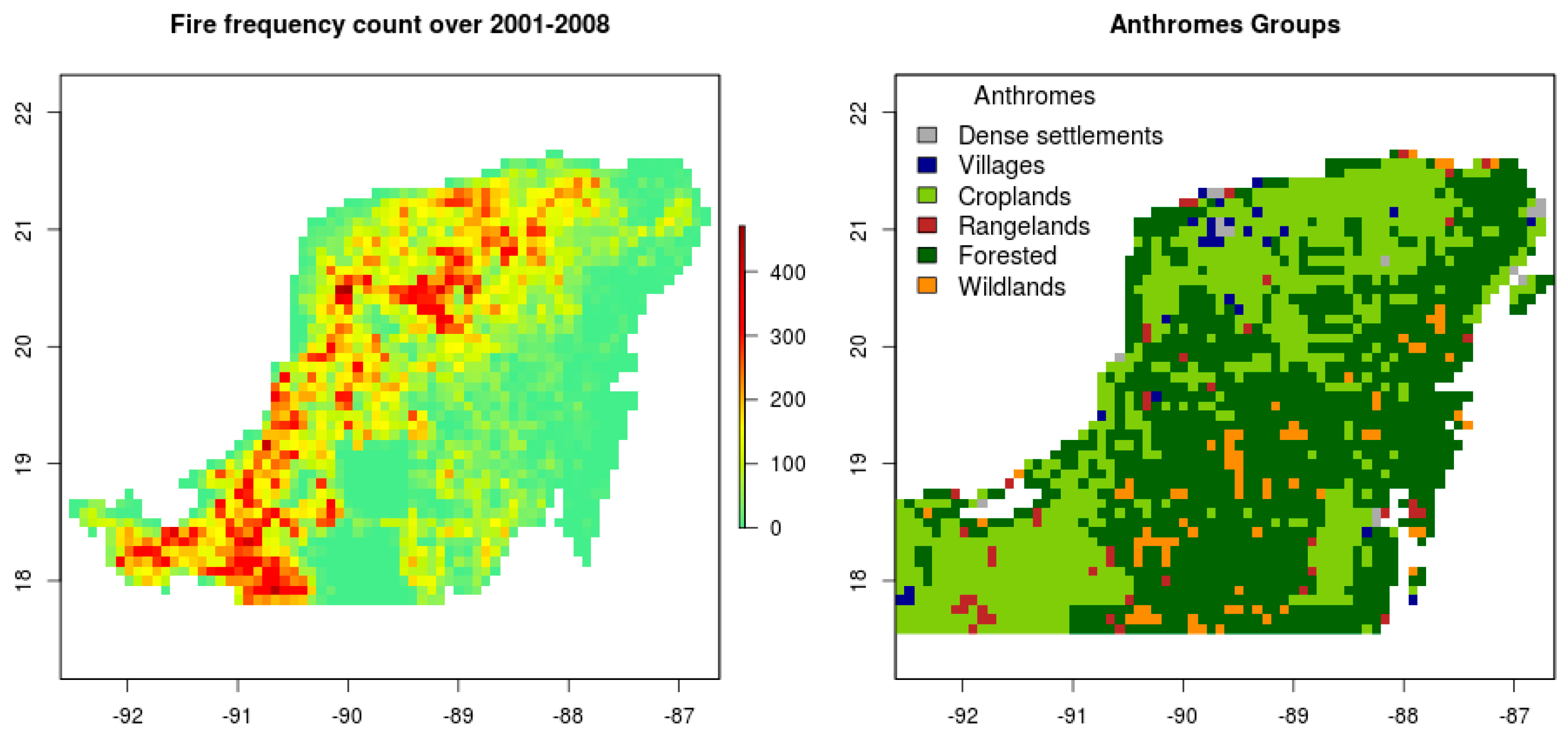
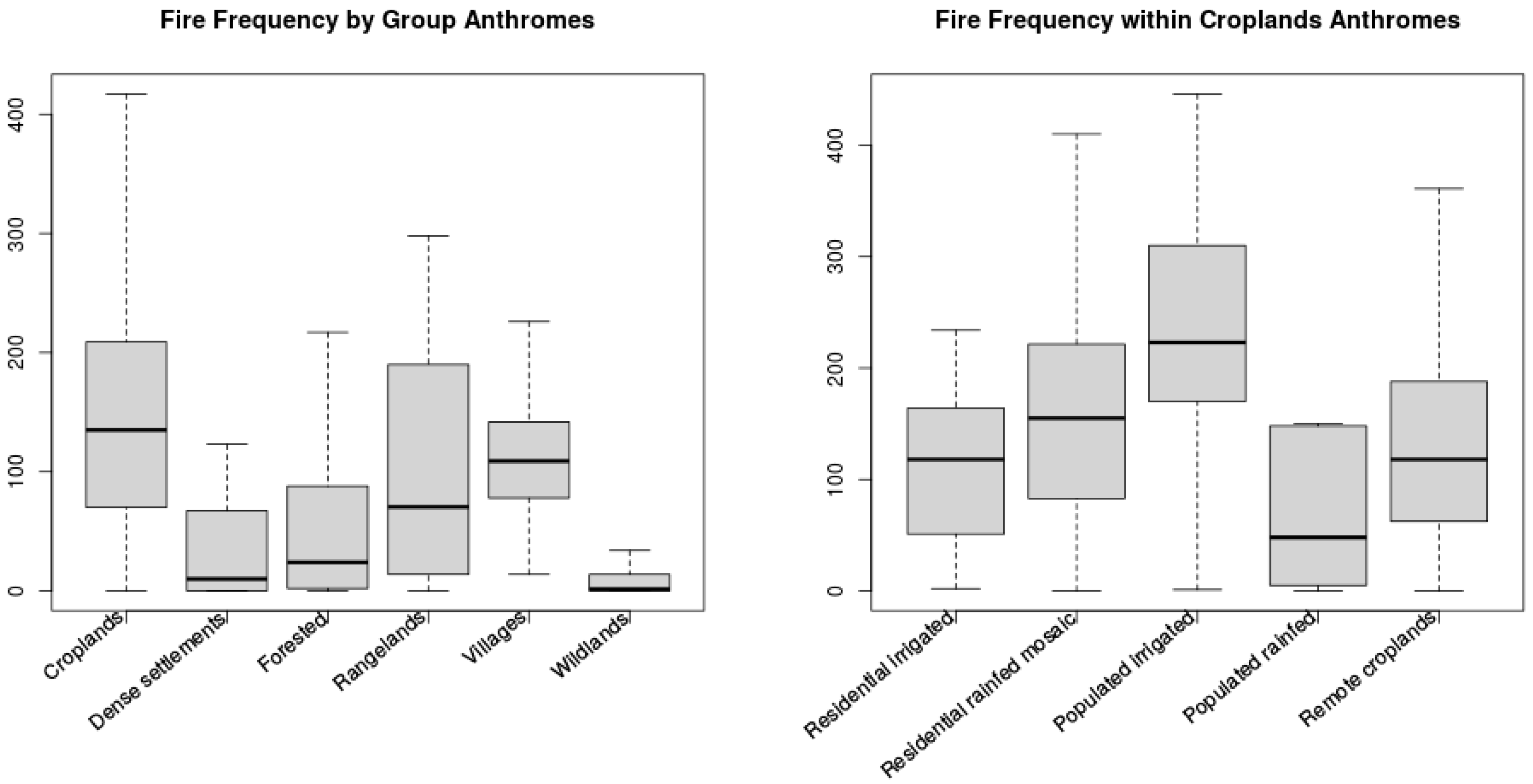
| Fire | No Fire | Row Total % | Total Study Area % | |
|---|---|---|---|---|
| Forest Persistence | 29.3% -Error resulting from database mismatch -Error of commission in MODIS Active Fire product -Error induced by aggregation of land cover data | 70.7% -Core areas of mature forest that have persisted for at least 17 years (1990–2007) -Protected areas with a predominance of mature forest -Areas of planned selective forest extraction that have not been extracted in 17 years or longer (under rotation management) | 100 | 54 |
| Non Forest Persistence | 60.8% -Areas where fire is used to convert from non-forest vegetation land covers to other non-forest vegetation land covers (e.g., agriculture to urban) -Areas of active non-forest land-uses -Error resulting from database mismatches | 39.18% -Areas under intensive land-uses that do not require land clearing for prolonged periods (e.g., citrus agriculture, urban) -Secondary vegetation of at least 10 years including forest not considered mature by CAB 2009. This can include forest regrowth (forest transition). -Forested areas of forest communities that have been extracted in the last 10 years and are growing back -Seasonal agricultural areas currently fallow (e.g., milpa) | 100 | 43 |
| Change (Forest to Non-Forest) | 86.0% -All land cover changes (conversion and some modification) preceded by land clearing by fire (i.e., deforestation) -Core forest areas that are heavily deforested with more intense use of land clearing by fire | 13.7% -Error of omission in MODIS Active Fire product -Error resulting from database mismatches -Land changes that do not require fire -Fringe areas that are cleared without fire after the core area has been cleared with fire -Fringe areas that are cleared with low intensity fire that is not detected by MODIS Active Fire product | 100 | 1 |
| Column TOTAL% | 45% | 36% | 100 | 100 |
| CAT | REF | INTE | CY | FIRE | Odds CY | Odds FIRE |
|---|---|---|---|---|---|---|
| CH (3) | FP (1) | −4.67 | −3.55 | 1.92 | 0.03 | 6.79 |
| NFP (2) | −6.07 | −3.46 | 0.20 | 0.03 | 1.22 | |
| CH Average | −5.37 | −3.50 | 1.06 | 0.03 | 4.00 | |
| FP (1) | CH (3) | 4.67 | 3.55 | −1.92 | 34.66 | 0.15 |
| NFP (2) | −4.38 | 0.07 | −1.72 | 1.07 | 0.18 | |
| FP Average | 0.15 | 1.81 | −1.82 | 17.87 | 0.16 | |
| NFP (2) | CH (3) | 9.05 | 3.48 | −0.20 | 32.43 | 0.82 |
| FP (1) | 4.38 | −0.07 | 1.72 | 0.94 | 5.59 | |
| FP Average | 6.71 | 1.71 | 0.76 | 16.68 | 3.20 |
| Pairwise Comparison | Coefficients | Standard Error | t-Stat | p-Values |
|---|---|---|---|---|
| Dense settlements–Croplands | −1.38688 | 0.43059 | −3.2209 | 0.0121 |
| Forested–Croplands | −0.92198 | 0.06997 | −13.1762 | 0 |
| Rangelands–Croplands | −0.35406 | 0.26321 | −1.3452 | 0.7146 |
| Villages–Croplands | −0.28199 | 0.32807 | −0.8595 | 0.9435 |
| Wildlands–Croplands | −2.29463 | 0.19565 | −11.7283 | 0 |
| Forested–Dense settlements | 0.46491 | 0.42934 | 1.0828 | 0.8616 |
| Rangelands–Dense settlements | 1.03282 | 0.49872 | 2.0709 | 0.2552 |
| Villages–Dense settlements | 1.10489 | 0.53579 | 2.0622 | 0.2593 |
| Wildlands–Dense settlements | −0.90775 | 0.4666 | −1.9454 | 0.3214 |
| Rangelands–Forested | 0.56791 | 0.26118 | 2.1744 | 0.2076 |
| Villages–Forested | 0.63999 | 0.32644 | 1.9605 | 0.3129 |
| Wildlands–Forested | −1.37266 | 0.1929 | −7.1159 | 0 |
| Villages–Rangelands | 0.07207 | 0.41346 | 0.1743 | 1 |
| Wildlands–Rangelands | −1.94057 | 0.31874 | −6.0882 | 0 |
| Wildlands–Villages | −2.01264 | 0.37409 | −5.3801 | 0 |
| Pairwise–Comparison | Coefficients | Standard Error | t-Stat | p-Values |
|---|---|---|---|---|
| Populated rainfed cropland–Populated irrigated cropland | 0.25239 | 0.22555 | 1.119 | 0.7646 |
| Remote croplands–Populated irrigated cropland | 0.572 | 0.25835 | 2.214 | 0.1453 |
| Residential irrigated cropland–Populated irrigated cropland | −0.61118 | 0.41094 | −1.4873 | 0.5244 |
| Residential rainfed mosaic–Populated irrigated cropland | 0.08091 | 0.22337 | 0.3622 | 0.9955 |
| Remote croplands–Populated rainfed cropland | 0.31961 | 0.14756 | 2.166 | 0.1615 |
| Residential irrigated cropland–Populated rainfed cropland | −0.86357 | 0.352 | −2.4533 | 0.0827 |
| Residential rainfed mosaic–Populated rainfed cropland | −0.17148 | 0.07017 | −2.4437 | 0.0848 |
| Residential irrigated cropland–Remote croplands | −1.18318 | 0.37387 | −3.1647 | 0.0105 |
| Residential rainfed mosaic–Remote croplands | −0.49109 | 0.14421 | −3.4054 | 0.0043 |
| Residential rainfed mosaic–Residential irrigated cropland | 0.69209 | 0.35061 | 1.974 | 0.2396 |
© 2017 by the authors. Licensee MDPI, Basel, Switzerland. This article is an open access article distributed under the terms and conditions of the Creative Commons Attribution (CC BY) license (http://creativecommons.org/licenses/by/4.0/).
Share and Cite
Millones, M.; Rogan, J.; II, B.L.T.; Parmentier, B.; Harris, R.C.; Griffith, D.A. Fire Data as Proxy for Anthropogenic Landscape Change in the Yucatán. Land 2017, 6, 61. https://doi.org/10.3390/land6030061
Millones M, Rogan J, II BLT, Parmentier B, Harris RC, Griffith DA. Fire Data as Proxy for Anthropogenic Landscape Change in the Yucatán. Land. 2017; 6(3):61. https://doi.org/10.3390/land6030061
Chicago/Turabian StyleMillones, Marco, John Rogan, B.L. Turner II, Benoit Parmentier, Robert Clary Harris, and Daniel A. Griffith. 2017. "Fire Data as Proxy for Anthropogenic Landscape Change in the Yucatán" Land 6, no. 3: 61. https://doi.org/10.3390/land6030061





